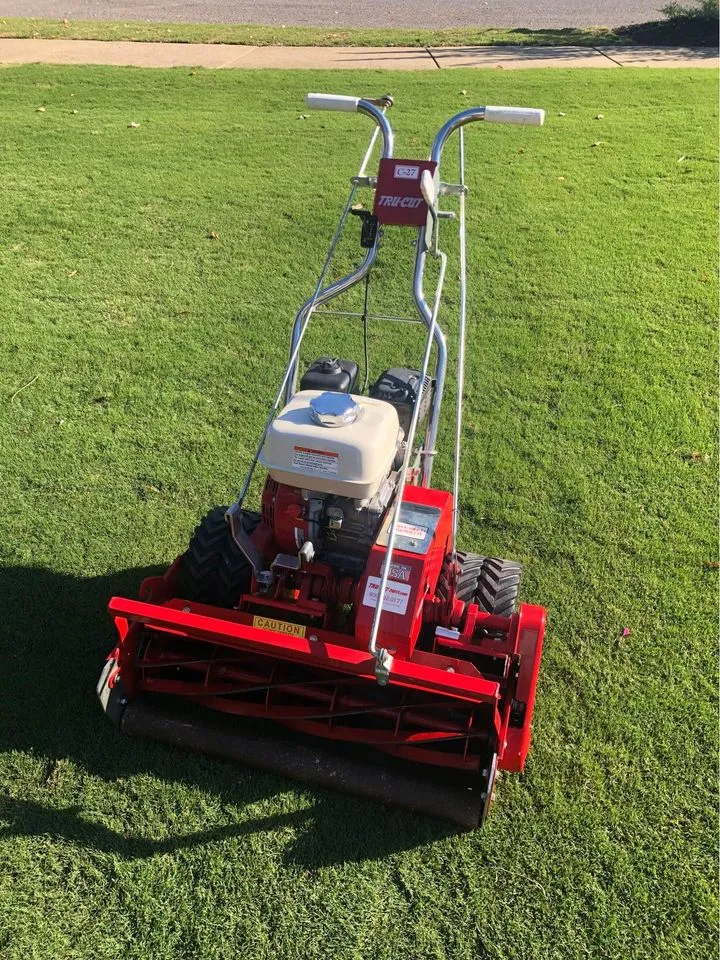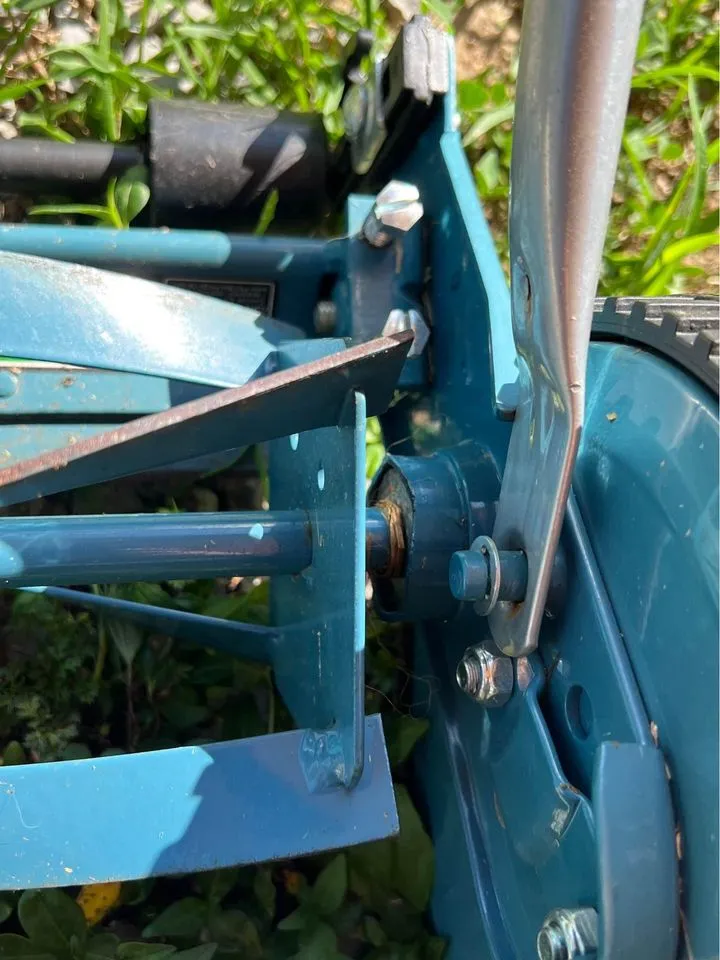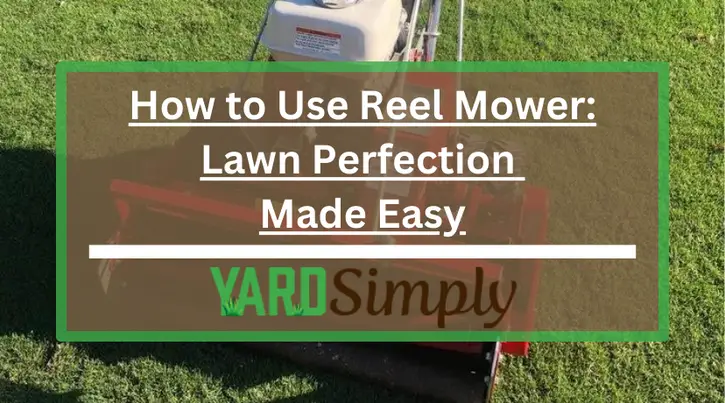As a seasoned lawn care professional with extensive experience in eco-friendly lawn maintenance, I understand the intricacies of using a reel mower effectively.
This introduction is designed to guide you through the essential techniques and considerations for maximizing the performance of your reel mower.
Drawing from my hands-on experience, I’ll provide practical insights and tips to help you achieve a beautifully manicured lawn. Trust in my expertise as we delve into the art of using a reel mower, ensuring every step you take is informed and effective.
Let’s begin this journey towards mastering the use of your reel mower for a healthier, greener lawn.
Quick Summary
- To use a reel mower effectively, adjust the cutting height, ensure sharp blades, and maintain a steady pace while mowing in straight, overlapping lines.
- Familiarize yourself with the reel mower’s components, like the reel, bedknife, and height adjustment feature, to maximize its efficiency and precision in lawn care.
- Studies have shown that using a reel mower significantly reduces carbon footprint compared to gas-powered mowers, contributing to environmental conservation.
- In my experience, reel mowers not only provide a superior cut but also offer a satisfying, eco-friendly approach to lawn maintenance.
How to Use a Reel Mower
- Clear the Lawn: Remove any sticks, stones, or debris.
- Adjust Blade Height: Set the blades to your preferred grass length, usually 2-3 inches.
- Plan Your Path: Decide on straight lines or a pattern.
- Start Mowing: Push the mower forward at a steady pace. Overlap each pass slightly.
- Turn Carefully: Lift the front slightly to turn at the end of a row.
- Edge Trimming: Use a hand trimmer for edges and corners.
- Clean the Mower: Brush off grass and debris after use.
- Regular Maintenance: Sharpen blades and lubricate as needed.
Understanding Your Reel Mower
Before we get deeper, it’s crucial I grasp the basics of my reel mower.
I’ll start by breaking down its components, understand the benefits it brings to my lawn, and explore the different types available.
This knowledge won’t only enhance my mowing experience but also ensure I’m making the most out of this eco-friendly tool.
Components of a Reel Mower
Understanding your reel mower starts with familiarizing yourself with its essential components.
The heart of the machine is the reel, a cylindrical assembly of blades that spin as I push the mower forward, slicing the grass with a scissor-like action.
Attached to this is the bedknife, a stationary blade that works in conjunction with the reel blades to cut the grass.
The mower’s body, or frame, supports these cutting mechanisms and connects to the wheels, which allow me to maneuver the mower across my lawn.
I also find the handle, which I grip to push the mower, integral for steering and controlling the machine.
Lastly, the height adjustment feature lets me set how short I want my grass, ensuring my lawn looks exactly the way I like it.
Advantages of Using a Reel Mower

One major advantage of using a reel mower is that it provides a precise, clean cut, promoting healthier grass growth.
Unlike rotary mowers that tear and bruise the grass, potentially exposing it to diseases, a reel mower acts like a pair of scissors, ensuring a healthy lawn.
Furthermore, it’s incredibly quiet. I can mow early in the morning or late in the evening without worrying about disturbing my neighbors. It’s also environmentally friendly, emitting no pollutants and requiring no gas or electricity.
I’ve found it to be a great workout, too, pushing it around the yard gives me a decent physical activity. Plus, it’s simple to maintain. Without the need for fuel or complicated engine parts, keeping it in top shape is straightforward.
Types of Reel Mowers
While exploring the benefits of reel mowers, it’s essential to delve into the different types available to find the best fit for your lawn care needs.
Firstly, there’s the manual reel mower, which relies solely on your pushing force to cut the grass. It’s perfect for small to medium-sized lawns and offers a quiet, eco-friendly option.
Next, we’ve got the electric reel mowers, a step up in convenience, suitable for those who prefer a bit of assistance without resorting to gas-powered models. These are great for achieving a precise cut with minimal effort.
Lastly, there are gas-powered reel mowers, designed for larger lawns where manual or electric models mightn’t be efficient. Each type has its unique advantages, and choosing the right one depends on your lawn size, topography, and personal preferences.
Preparing to Mow
Before I start mowing, there’s a bit of prep work I need to tackle to ensure everything goes smoothly.
First, I’ll walk you through how I get my lawn ready.
Then, we’ll look at adjusting the mower for the perfect cut.
Finally, we’ll cover some essential safety tips.
It’s all about setting the stage for an efficient and safe mowing experience.
Lawn Preparation
Preparing your lawn for mowing with a reel mower ensures a smoother cut and healthier grass. I always start by removing any large sticks, stones, or debris that could hinder the blades’ path and potentially damage the mower.
It’s crucial to check for any uneven spots or holes in the ground too; leveling these areas prevents the mower from getting stuck and ensures an even cut.
I also like to walk the perimeter of the area I’m going to mow, making mental notes of any obstacles I need to navigate around. This step saves me time and effort during the mowing process.
Lastly, ensuring the grass isn’t overly wet from recent rains or watering helps the reel mower glide smoothly and cuts the grass more efficiently.
Mower Adjustment

After ensuring the lawn is ready and free from obstacles, it’s crucial to adjust the reel mower for the optimal cutting height. I start by checking the manufacturer’s guidelines, as each model has its ideal settings.
I find the adjustment levers on either side of the mower. They’re usually near the wheels, allowing me to raise or lower the blades. I aim for a height that cuts the grass without scalping it, typically between 2 to 3 inches, depending on the grass type.
Next, I ensure the blades are sharp and properly aligned. A dull blade tears the grass, leaving it susceptible to disease. I do a quick check by manually spinning the reel; if it slices through a piece of paper evenly, it’s set.
This prep ensures my mowing is efficient and the lawn health is preserved.
Safety Precautions
As I gear up to mow, I prioritize safety by donning protective clothing and eyewear to prevent any accidents. I ensure my shoes are sturdy, offering a firm grip to avoid slips.
It’s also key to check the lawn for any debris or objects that could become hazardous when hit by the mower blades. I always make sure the area’s clear of pets and people, especially kids, to avoid any potential mishaps.
Before starting, I give the mower a quick once-over, confirming it’s in proper working order. Blades should be sharp and the mower free of any damage that could compromise its function.
I’m mindful of my surroundings, maintaining a steady pace and never rushing. Safety’s not just a precaution; it’s the foundation of a successful mowing session.
Our Verdict
After spending quality time with my favorite reel mower, I’m genuinely impressed. The prep work, like sharpening the blades and setting the ideal height, initially seemed daunting, but the outcome was incredibly rewarding.
Mowing in cooler temperatures not only made the task more pleasant for me, but it also kept my lawn in top condition.
Yes, maintaining those straight, overlapping lines demanded extra effort, but the resulting manicured look of my lawn made every push worthwhile. What’s more, knowing I’m reducing my carbon footprint while caring for my lawn feels fantastic.
From my personal experience, I confidently recommend the reel mower as an excellent choice for environmentally-conscious homeowners who enjoy a hands-on approach to lawn care.
Frequently Asked Questions
Can a reel mower handle tall or wet grass effectively, and are there specific techniques to use in these conditions?
I’ve found that a reel mower struggles with tall or wet grass. It’s best to cut grass when it’s dry and maintain a moderate height. Mowing more frequently prevents the grass from getting too tall.
How does the use of a reel mower impact the health of the lawn compared to rotary mowers, particularly in terms of promoting thick, healthy growth?
I’ve found that using a reel mower often leads to a healthier lawn compared to rotary mowers. It seems to promote thicker growth by cutting the grass more cleanly, which helps prevent disease and damage.
Are there any safety precautions specific to reel mowers that users should be aware of, especially when children or pets are present?
I’m curious about safety tips for using reel mowers, especially with kids or pets around. It’s vital to ensure everyone’s safety while maintaining the lawn, so I’m eager to learn any specific precautions I should take.
How frequently should the blades on a reel mower be sharpened to maintain optimal performance, and can this be done at home or does it require professional service?
I’ve learned that reel mower blades should be sharpened every cutting season to keep them performing well. You can sharpen them at home with a kit, but sometimes it’s better to get professional service.
Can reel mowers be used on all types of grass, or are they better suited for certain varieties? How does the mower perform on uneven terrain?
I’ve found that reel mowers work best on certain types of grass, especially finer, softer varieties. They struggle a bit on uneven terrain, so it’s important to keep your lawn relatively flat for best results.


